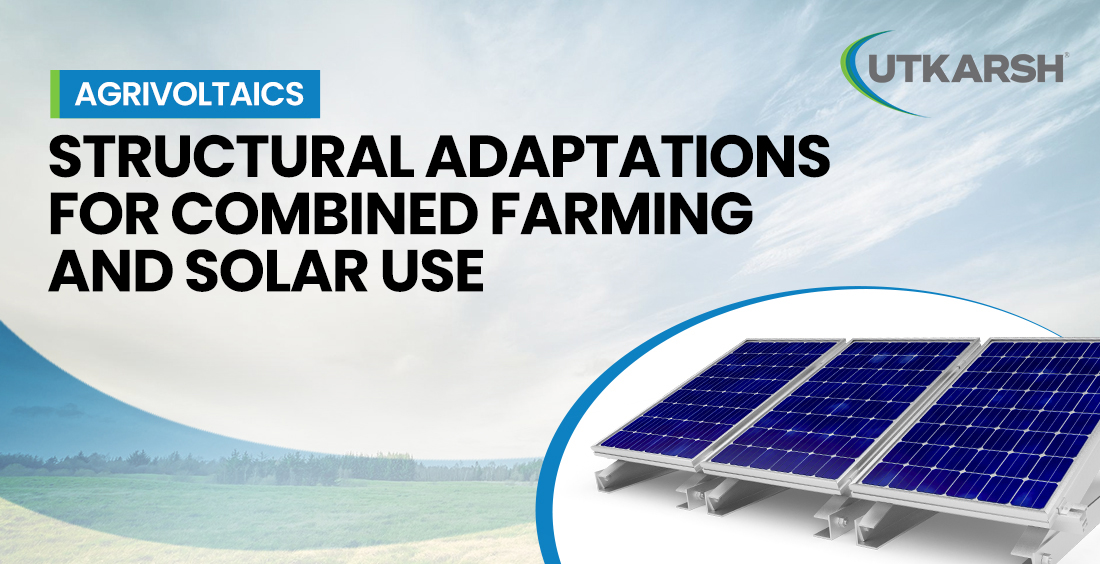Agrivoltaics: Structural Adaptations for Combined Farming and Solar Use

The rising global demand for food and clean energy has brought forth a new solution: Agrivoltaics, a sustainable approach towards integrating solar energy production with agricultural practices. In this method, two essential purposes are solved in the same piece of land. The first purpose is crop cultivation, and the second is solar power generation. In simpler terms, agrivoltaics involve a solar panel structure that coexists with farming while maximizing renewable energy output.
What is Agrivoltaics?
Agrivoltaics, in simple terms known as solar agriculture, is a strategic combination of farming and solar power that works together on a piece of land. Instead of using the land only for agriculture or utilising it only for a solar panel structure. When both are combined practically, the solar panel produces clean electricity while the crops below the solar panel benefit from reduced heat, save water, and create a better environment for growth.
For this process to work well, strong ground-mounted solar structures are used. These are custom-designed frames that lift solar panels to certain heights above the ground. While raising the panels, enough space is left underneath for the farmers to grow crops or move small farming equipment. The height and angle of the panels are carefully planned so that sunlight can reach both the panels and crops, creating a balance between farming and solar energy.
Structural Adaptation for Agrivoltaics
- Elevated Solar Panel Height: In the agrivoltaics method, the structure height is increased, which provides enough cleared space for farming, crops to grow, and mobilising small tools. This customised design ensures agricultural productivity is not compromised while getting the maximum renewable energy.
- Optimised Solar Tracking Systems: Unlike fixed structure panels, an advanced solar tracking system allows panels to follow the sun’s path throughout the day. This upgrade of systems increases the energy efficiency and regulates the shading pattern of crops, ensuring better growth conditions.
- Fixed-Tilt Ground-Mounted Solar Structure: These structures are engineered with precision to ensure long-term durability. These structures keep the solar panel firmly in place at a fixed angle to ensure maximum sunlight throughout the day. The strength and stability of the fixed tilt structure are ideal for farming and solar projects.
- Durability and Weather Resistance: In agrivoltaics, the resistance to weather variation, such as wind, rain, and humidity, should be superior, as it would not only damage the plates but also the crops below the solar panel structure.
- Customisation Layout for Agriculture: Agrivoltalic project required a specialised layout structure considering crop type, spacing, and irrigation patterns. Flexible structure helps to keep the harmony in balancing and protecting both crops and panels together.
Advantages of Agrivoltaics
Agrivoltaics is not just about zero-waste land or initiating a renewable energy source, mentioning a zero carbon footprint. By combining solar energy with food production creates a win-win situation for the environment, farmers, and energy consumers.
These are some key advantages:
- Dual land use: Perhaps the biggest advantage of agrivoltaics is that the same piece of land can be used for two purposes: farming and energy production. Traditionally, agriculture and solar power projects compete for land, but with this evolutionary approach, which maximizes land productivity, especially in a country like India, where farm land is limited and in demand.
- Improve Crop Yield: Another great advantage is that crops get shade with these large solar panels, which protect them from extreme sunlight while reducing heat stress to the farmers. This effective shading keeps the crop moisture intact.
- Energy Efficiency: with the advanced solar tracking systems, panels directly follow the sun’s rays, which enables to capture of more sunlight and generates higher energy output compared to fixed solar panels.
- Economic Sustainability: Agrivoltaics opens up new income opportunities for farmers while continuing to earn from additional solar structure installation. Farmers can either sell excess electricity or use it to run an irrigation system that reduces the dependency on costly fossil fuels. This dual-income resource can give a financial system.
- Reduce Water Consumption: The shade with a solar panel helps to reduce excessive heat, therefore less amount of water evaporates from the soil which resulting in less water resource in the irrigation field more cost-effective for farmers.
- Climate Resiliance: Extreme weather conditions like heatwaves are common nowadays. Agrivoltic system acts as a protective layer for the crops, which reduces the risk of crop failure during harsh climate conditions.
- Rural Development with More Job Creation: The Agrivoltaic project can create employment opportunities in rural areas for skilled workers required for installation, repair, and maintenance. Moreover, this strategy can greatly influence the rural people to adapt solar panel structure.
Utkarsh India’s Role in Advancing Solar Agriculture
Utkarsh India is one of the trusted Indian brands with four decades of industrial experience. We never fail to impress with our precision-engineered solar panel structure. Our ground mounted solar structure and fixed-tilt solution are best suited for the agrivoltaics method. This structure is becoming a boon to the agricultural sector, fulfilling farmers' needs with a renewable source of energy. Moreover, surviving dual purpose on a single piece of land.
Wrapping Up
Agrivoltaics represent the future of sustainability while shaping food security, and clean energy goes hand in hand. Utkarsh India empowers the farmers and industries to embrace the green future and step up towards more such innovative ideas in the future. We have a special wing dedicated to research and development, where many such ideas are grounded and analysed with sincerity. However, agrivoltaics stands as a proven pathway to maximize efficiency with eco-conscious responsibility.